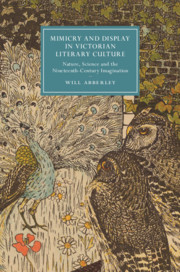 Mimicry and Display in Victorian Literary Culture
Mimicry and Display in Victorian Literary Culture Evolution and the Ethics of Appearance in Thomas Hardy’s Fiction
Published online by Cambridge University Press: 16 May 2020
Analysingthe fiction of Thomas Hardy, Chapter 4 considers Hardy’s depictions of deception, concealment and misleading appearances among humans alongside his interest in adaptive appearance. This interest clashed with Hardy’s channelling of the pastoral, which characterised the natural world and rural life by honesty and transparency. Critics have noted that Hardy’s fiction problematizes the ethics of honesty. It is argued here that the logic of adaptive appearance energised this tendency as characters’ fates depend on chance misperceptions and ambiguous appearances. This sense of Darwinian contingency complicates characters’ moral agency by suggesting that many of their acts, which have the effect of deceiving, are unconscious. Apparently purposeful behaviours blur with the more mechanised displays of natural and sexual selection. Through his evolutionary vision, Hardy sometimes reframes honesty and dishonesty as outgrowths of opposing primitive instincts toward altruism and egoism. However, this utilitarian framework also rendered deception morally ambiguous, allowing for the possibility of noble deceptions that would spare others pain. Hardy’s fiction further biologized deception by depicting physical bodies that hid or falsified their owners’ identities. Random variations and chance resemblances cause characters to interpret erroneous ancestral histories in each other, sometimes with disastrous consequences.
To save this book to your Kindle, first ensure [email protected] is added to your Approved Personal Document E-mail List under your Personal Document Settings on the Manage Your Content and Devices page of your Amazon account. Then enter the ‘name’ part of your Kindle email address below. Find out more about saving to your Kindle.
Note you can select to save to either the @free.kindle.com or @kindle.com variations. ‘@free.kindle.com’ emails are free but can only be saved to your device when it is connected to wi-fi. ‘@kindle.com’ emails can be delivered even when you are not connected to wi-fi, but note that service fees apply.
Find out more about the Kindle Personal Document Service.
To save content items to your account, please confirm that you agree to abide by our usage policies. If this is the first time you use this feature, you will be asked to authorise Cambridge Core to connect with your account. Find out more about saving content to Dropbox.
To save content items to your account, please confirm that you agree to abide by our usage policies. If this is the first time you use this feature, you will be asked to authorise Cambridge Core to connect with your account. Find out more about saving content to Google Drive.